plenty of something
Algonquian Place-Name, used by the Nipmuck or Pennacook, meaning "low land" or "place to unload canoes"
The Algonquian are one of the most populous and widespread North American native language groups. Historically, the peoples were prominent along the Atlantic Coast and into the interior along the Saint Lawrence River and around the Great Lakes. This grouping consists of the peoples who speak Algonquian languages.
Algonquin is a particular language of Indigenous Peoples in the northeast. It is part of the Algonquian family of languages, one of the most populous and widespread North American native language groups. Often a collective group of tribal nations who speak Algonquian are referred to "Algonquian-speaking" peoples, because they also shared cultural similarities. Some tribal nations that would be referred to in this way include the Wampanoag, Narragansett, Abenaki, Pequot and Mohegan.
There is also a tribal nation called the Algonquian, located along the Saint Lawrence River and around the Great Lakes. They, too, spoke Algonquian.
The Algonquin Tribe was a small tribe in Northern Michigan and Canada, that was forced further north after the formation of the Iroquois Confederacy. The Algonquin Tribe often is confused with the Algonquian-speaking peoples. Although the source of the word is unclear, some scholars believe it’s derived from the Malecite word meaning, “they are our relatives.” Others assert Algonquin means “at the place of spearing fishes and eels from the bow of a canoe,” and lastly, “those that are dancing.” The Algonquins call themselves “Anishnabe,” or “original person.”
A look-out or place of observation
Located in the southwestern portion of Martha's Vineyard (Noepe), Aquinnah (also known as Gay Head) has been inhabited by the Wampanoag people for thousands of years.
A person who studies history through the examination of objects remaining from past cultures.
A time period in Connecticut (9,000 - 3,000 years before present), during which warmer temperatures led to an explosion of Flora and Fauna, allowing Indigenous Peoples to gather food in addition to hunt for it.
A person studies plant remains that are found at an archeology site
 A man-made object, such as a tool, that reveals something about the people who made and/or used it.
A man-made object, such as a tool, that reveals something about the people who made and/or used it.The place between the forks of the brook.
(also "Bullrush") A tall rushlike water plant of the sedge family. Native to temperate regions of the northern hemisphere, it has been widely used for weaving and is grown as an aid to water purification in some areas.
The upper part of a turtle's exoskeleton, or upper shell
Algonquian word used by the Wampanoag meaning "separated island"
The leftover material when something Organic is burned, like wood, plants or animals
A wild, dashing stream
Curling inward
when Indigenous Peoples first came into contact with Europena settlers, approximately 400 years ago
Tying materials made from a variety of sources, including but not limited to, animal Sinew, Indian hemp, milkweed, wild flax and the inner bark of the Basswood Swamp Ash.
The outer green leaves surrounding the corn cob, which are usually peeled and discarded. The could be woven into moccassins, mats, baskets and dolls. Discarded corncobs could used as scrubbers and container stoppers.
raise or grow (plants), especially on a large scale for commercial purposes
spread over a wide area
 Bones, teeth, antlers seeds, pollen, mollusks are all ecofacts. Note: If a deer bone found in an archaeological context is unmodified, it is an ecofact. However, if the bone was modified by humans for use, then the bone is instead an artifact.
Bones, teeth, antlers seeds, pollen, mollusks are all ecofacts. Note: If a deer bone found in an archaeological context is unmodified, it is an ecofact. However, if the bone was modified by humans for use, then the bone is instead an artifact.remove completely
the process of eroding, particularly of soil being unfavorably moved by wind or water
The animals of a particular place or time
items left behind when an animal dies, such as bones or shells
Producing or capable of producing abundant vegetation or crops
The plants of a particular region, habitat, or geological period
A long, shallow groove on a surface
To protect a place from danger
North: White, air, animals, receive energy, mental aspect, wisdom and logicEast: Yellow, sun/fire, determines energy, spirtual aspect, illumination and enlightenmentSouth: Red, water, plants, gives energy, emotional aspect, trust and innocenceWest: Black, earth/physical, holds energy, physical aspect, introspection and insightCentre: Learning self balance, beauty and harmony
 Animals that are hunted for food.
Animals that are hunted for food.A huge mass of ice that moves slowly over land / the time period during which glaciers covered large parts of the earth's land
A vine that is related to pumpkin and Squash that bears inedible fruit with ahard outer shell. When gourds are dried out and hollowed they can be usedto make tools and utensils.
A creator God for Indigenous Peoples; may be called a different name
To attach a tool (generally made of stone, bone or metal) to a handle in some way
An Indigenous place-name, meaning "place of sand bars"
A large group of animals, especially groups of large hoofed mammals (such as deer, moose, or caribou)
The art of cultivating plants in gardens to produce food and medicinal ingredients, or for comfort and ornamental purposes. Horticulturists are agriculturists who grow flowers, fruits and nuts, vegetables and herbs, as well as ornamental trees and lawns.
 An Indigenous place-name meaning "over or beyond the mountain"
An Indigenous place-name meaning "over or beyond the mountain"Native to the area
Plants that are not native to the local environment, and can cause environmental harm
Indigenous place-name meaning "the top is so hidden in the clouds"
At the high place, or hill.
Originated with the Haudenosaunee. Field played on ranged from 100 yards to 2 miles. Teams could be a handful or hundreds of players.Lacross was seen as a gift from the Creator. Seen as a medicine game – a game played in order to heal and/or strengthen people, and to settle disputes between Haudenosaunee clans.
an immature insect
a cord or rope used to secure something / to secure something with cord or rope
The manner of living in a society; the cultural practices of a groups, as well as its spoken and unspoken laws
The act of moving from one country, region, or place to another.
Huckleberry Hill
able to move easily
A soft leather slipper traditionally worn by certain Native American peoples. Moccasins were usually made out of deerskin or moose hide.
 The benevolent giant who created Noepe (Martha's Vineyard) and neighboring islands. He was particularly fond of the Aquinnah Wampanoag People and taught them how to fish and catch whales.
The benevolent giant who created Noepe (Martha's Vineyard) and neighboring islands. He was particularly fond of the Aquinnah Wampanoag People and taught them how to fish and catch whales.Algonquian word used by the Wampanoag meaning "in the midst of waters"
Algonquian word meaning "at the narrow point"
A cornmeal porridge made by the Wampanoag people. Can add berries, nuts and seeds and be sweetened with maple syrup.
A source of wealth provided by nature, such as forests, minerals, or water supplies.
Flooded or overflowed land
The point or corner
Algonquian word meaning "point of land on tidal river"
Pool-place
Word used by the Wampanoag for Martha's Vineyard Island
Indigenous place-name meaning "place between rivers"
House with 3 fires
Place of concealment
The process by which culture, history, rituals and stories are passed down verbally, instead of in written form, from generation to generation.
Something that is or was living
Also known as the Paleo-Indian Period, this time period in Connecticut featured a Tundra-like environment of huge trees and animals. The Paleo Period was 12,900 - 9,000 years before present.
An Indigenous place-name meaning "cleared land"
an energy bar of sorts, made of dried fruits and animals fat
A plant that lives more than two years, meaning it comes up every year. The term is often used to differentiate a plant from shorter-lived annuals and biennials.
An Indigenous place-name meaning "lake of the still water"
Wamponoag word for a "round bag," pouch
a system of written symbols that closely represent speech sounds
A name given by Indigenous Peoples, referring to natural features or geographic locations
An Indigenous place-name meaning "falls on the brook"
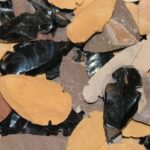 Deliberately worked stone was made into sharp points for use in spears and arrows.
Deliberately worked stone was made into sharp points for use in spears and arrows. A large, edible clam from the Atlantic coast of North America, having a hard purple and white rounded shell.
A large, edible clam from the Atlantic coast of North America, having a hard purple and white rounded shell.A place of drawing nets or where fish are taken in nets
Algonquian place-name meaning "long, tidal river" used by the Mohegans/Pequots for what would later be called the Connecticut River
Algonquian place-name meaning "where we change our route" later used to mean Quinnipiac River
A scientific process in which a person can determine how old an organic item is
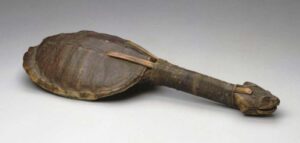 Made of a variety of materials. It is a piece that utilizes what Native People refer to as the Three Kingdoms or Nations: Animal Kingdom, represented by the container or feather decorations used; Mineral Kingdom, represented by rocks used for sound, or paint; Plant Kingdom, represented by the container (gourd) or a wooden handle.
Made of a variety of materials. It is a piece that utilizes what Native People refer to as the Three Kingdoms or Nations: Animal Kingdom, represented by the container or feather decorations used; Mineral Kingdom, represented by rocks used for sound, or paint; Plant Kingdom, represented by the container (gourd) or a wooden handle.when something or someone moves back
 Native American chief. A "sachem's house" referred to the largest Wigwam in a village where community members would gather. "Sachemdoms" referred to a tribe's geographic territory.
Native American chief. A "sachem's house" referred to the largest Wigwam in a village where community members would gather. "Sachemdoms" referred to a tribe's geographic territory.An Indigenous place-name meaning "where the river branches"
The individual bony plates made of keratin on a turtle's upper shell, or carapace. Most turtles have 13 large scutes in the middle of the carapace. Two pairs of 12-14 "marginal" scutes are located around the edge of the carapace. Many Native Americans likened the 13 central scutes to their 13 moon calendar
Inactive, little movement
The part of an animal that connects muscle to bone (tendon or ligament)
Although this is the fruit of a squash plant, it is eaten as a vegetable. Squash comes in many shapes and sizes and includes long-neck squash, yellow squash and green zucchini.
A dish made primarily of corn and beans and can have other sources of protein or vegetables added. The word succotash comes from the Wampanoag word msickquatash, meaning "boiled corn kernels."
food or drink as a source of nourishment
A method of preserving an animal's skin once it has been removed
An Indigenous place-name meaning "pPlace where the ground is level"
To be full of something
Relating to tension; capable of being drawn out or stretched
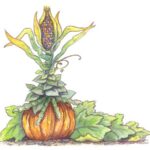 Traditionally, corn, bean, and squash were important crops planted together by the women of the tribe (and for that reason called "the three sisters"). The broad leaves of corn provided shelter from the sun; the corn stalk was a living stake for the bean and squash vines; and the squash vines provided good cover, ensuring maximum capture of rain and minimum erosion. The beans help replenish nitrogen used by corn.
Traditionally, corn, bean, and squash were important crops planted together by the women of the tribe (and for that reason called "the three sisters"). The broad leaves of corn provided shelter from the sun; the corn stalk was a living stake for the bean and squash vines; and the squash vines provided good cover, ensuring maximum capture of rain and minimum erosion. The beans help replenish nitrogen used by corn.a type of barn for drying tobacco leaves, generally very long with side slats that can be extended out for air flow
a long, narrow container for animals to drink or eat out of
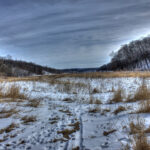 A generally bare piece of land where the ground is somewhat frozen
A generally bare piece of land where the ground is somewhat frozen Many Indigenous People refer to North America as Turtle Island. The name is based on a common Native Peoples' Creation myth or story.
Many Indigenous People refer to North America as Turtle Island. The name is based on a common Native Peoples' Creation myth or story.a plant that typically grows below a forest canopy
 A hollowed-out container, especially one that holds a liquid, like a bowl
A hollowed-out container, especially one that holds a liquid, like a bowlAn Indigenous Tribal Nation located in southeastern Massachusetts. As a word, Wampanoag can mean "People of the First Light, People of the Dawn, People of the Rising Sun." There are five federally recognized Wampanoag tribes: The Mashpee Wampanoag; the Aquinnah Wampanoag; the Herring Pond Wampanoag; the Assawompsett-Nemasket Band of Wampanoags; and the Pocasset Wampanoag.
 Algonquian word meaning "white shell bead." Wampum are purple and white beads made from the Quohog and Whelk (different from the conch in that it is a meat-eater living in temperate waters). The rareness of the purple beads makes them more valuable. Beads were made from shells that were polished and strung together in strands, belts or sashes, and used by Native Americans as ornament in ceremonial pledges or as a medium of exchange.
Algonquian word meaning "white shell bead." Wampum are purple and white beads made from the Quohog and Whelk (different from the conch in that it is a meat-eater living in temperate waters). The rareness of the purple beads makes them more valuable. Beads were made from shells that were polished and strung together in strands, belts or sashes, and used by Native Americans as ornament in ceremonial pledges or as a medium of exchange.An Indigenous tribal nation that lived in Wethersfield, Portland, Rocky Hill and Glastonbury, and is considered a "River Tribe." According to historians, the Wangunks had a palisaded fort at Red Hill. Archaeological evidence from this site suggests a Wetu was situated next to a colonial settler's house.
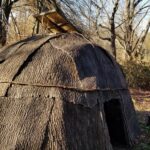 Domed home with one fire.
Domed home with one fire.Domed home with 2 fires.
 1620s, from Algonquian (probably Eastern Abenaki) wikewam "a dwelling," said to mean literally "their house;" also said to be found in such formations as wikiwam and Ojibwa wiigiwaam and Delaware wiquoam.
1620s, from Algonquian (probably Eastern Abenaki) wikewam "a dwelling," said to mean literally "their house;" also said to be found in such formations as wikiwam and Ojibwa wiigiwaam and Delaware wiquoam.Algonquian place-name meaning "good cedar swamp"
A time period in Connecticut (3,000 - 400 years before present) during which the environment was much like the present. This era ended at the time of Europen contact.
